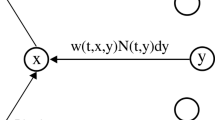Abstract
For large fully connected neuron networks, we study the dynamics of homogenous assemblies of interacting neurons described by time elapsed models. Under general assumptions on the firing rate which include the ones made in previous works (Pakdaman et al. in Nonlinearity 23(1):55–75, 2010; SIAM J Appl Math 73(3):1260–1279, 2013, Mischler and Weng in Acta Appl Math, 2015), we establish accurate estimate on the long time behavior of the solutions in the weak and the strong connectivity regime both in the case with and without delay. Our results improve (Pakdaman et al. 2010, 2013) where a less accurate estimate was established and Mischler and Weng (2015) where only smooth firing rates were considered. Our approach combines several arguments introduced in the above previous works as well as a slightly refined version of the Weyl’s and spectral mapping theorems presented in Voigt (Monatsh Math 90(2):153–161, 1980) and Mischler and Scher (Ann Inst H Poincaré Anal Non Linéaire 33(3):849–898, 2016).
Similar content being viewed by others
References
Baladron, J., Fasoli, D., Faugeras, O., Touboul, J.: Mean-field description and propagation of chaos in networks of Hodgkin-Huxley and FitzHugh-Nagumo neurons. J. Math. Neurosci. 2, 10–50 (2012)
Brunel, N.: Dynamics of sparsely connected networks of excitatory and inhibitory spiking networks. J. Comput. Neurosci. 8, 183–208 (2000)
Chevallier, J.: Mean-field limit of generalized Hawkes processes. Stoch. Process. Appl. 127(12), 3870–3912 (2017)
Coleman, B., Mizel, V.: Norms and semi-groups in the theory of fading memory. Arch. Ration. Mech. Anal. 23, 87–123 (1966)
De Masi, A., Galves, A., Löcherbach, E., Presutti, E.: Hydrodynamic limit for interacting neurons. J. Stat. Phys. 158(4), 866–902 (2015)
Delattre, S., Fournier, N., Hoffmann, M.: Hawkes processes on large networks. Ann. Appl. Probab. 26(1), 216–261 (2016)
Diekmann, O., van Gils, S., Verduyn, L., Sjoerd, M., Walther, H.: Delay equations applied mathematical sciences. Funct. Complex Nonlinear Anal. 110, xii+534 (1995)
Fournier, N., Löcherbach, E.: On a toy model of interacting neurons. Ann. Inst. Henri Poincar Probab. Stat. 52(4), 1844–1876 (2016)
Gerstner, W., Kistler, W.M.: Spiking Neuron Models. Single Neurons, Populations, Plasticity. Cambridge University Press, Cambridge (2002)
Hodara, P., Löcherbach, E.: Hawkes processes with variable length memory and an infinite number of components. Adv. Appl. Probab. 49(1), 84–107 (2017)
Mischler, S.: Semigroups in Banach spaces—splitting approach for spectral analysis and asymptotics estimates (work in progress)
Mischler, S.: Erratum: spectral analysis of semigroups and growthfragmentation equations, hal-01422273
Mischler, S., Scher, J.: Spectral analysis of semigroups and growth-fragmentation equations. Ann. Inst. H. Poincaré Anal. Non Linéaire 33(3), 849–898 (2016)
Mischler, S., Weng, Q.: Relaxation in time elapsed neuron network models in the weak connectivity regime hal-01148645, Acta Appl. Math. (2015) (to appear)
Pakdaman, K., Perthame, B., Salort, D.: Dynamics of a structured neuron population. Nonlinearity 23(1), 55–75 (2010)
Pakdaman, K., Perthame, B., Salort, D.: Relaxation and self-sustained oscillations in the time elapsed neuron network model. SIAM J. Appl. Math. 73(3), 1260–1279 (2013)
Quiñinao, C.: A microscopic spiking neuronal network for the age-structured model. Acta Appl. Math. 146, 29–55 (2016)
Robert, P., Touboul, J.D.: On the dynamics of random neuronal networks. J. Stat. Phys. 165(3), 545–584 (2016)
Ribari$\check{c}$, M., Vidav, I.: Analytic properties of the inverse $A(z)^{-1}$ of an analytic linear operator valued function $A(z)$. Arch. Ration. Mech. Anal. 32, 298–310 (1969)
Touboul, J., Hermann, G., Faugeras, O.: Noise-induced behaviors in neural mean field dynamics. SIAM J. Appl. Dyn. Syst. 11(1), 49–81 (2012)
Tristani, I.: Boltzmann equation for granular media with thermal force in a weakly inhomogeneous setting. J. Funct. Anal. 270(5), 1922–1970 (2016)
Voigt, J.: A perturbation theorem for the essential spectral radius of strongly continuous semigroups. Monatsh. Math. 90(2), 153–161 (1980)
Acknowledgements
The research leading to this paper was (partially) funded by the French “ANR blanche” project Kibord: ANR-13-BS01-0004. C. Q. acknowledges the funding of CONICYT Postdoctorado 2017 No. 3170435 as well as the CEREMADE at University Paris-Dauphine for the invitation in February 2018. The authors also acknowledge the anonymous referees for the conscientious reading and the many suggestions they formulate for improving the present work.
Author information
Authors and Affiliations
Corresponding author
Rights and permissions
About this article
Cite this article
Mischler, S., Quiñinao, C. & Weng, Q. Weak and Strong Connectivity Regimes for a General Time Elapsed Neuron Network Model. J Stat Phys 173, 77–98 (2018). https://doi.org/10.1007/s10955-018-2122-x
Received:
Accepted:
Published:
Issue Date:
DOI: https://doi.org/10.1007/s10955-018-2122-x




